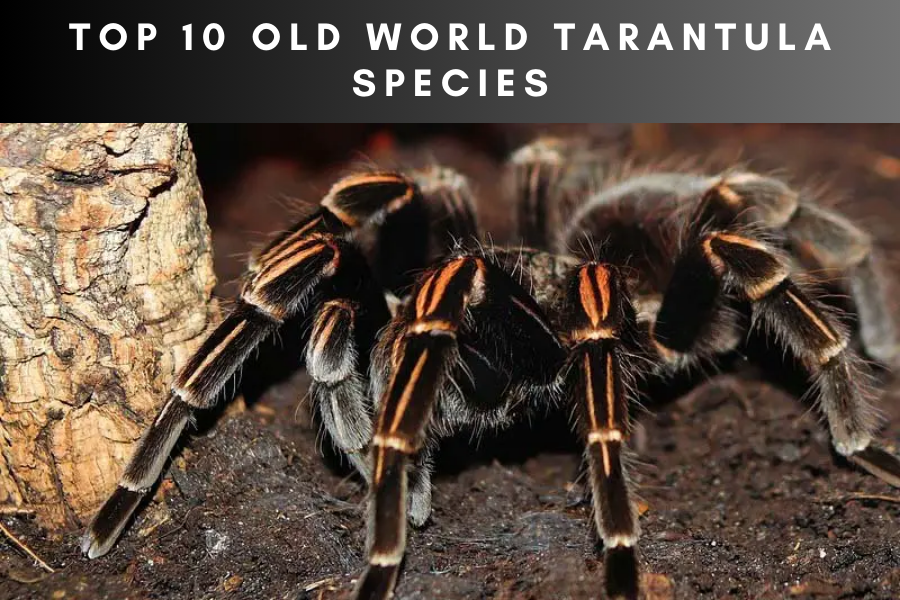Top 10 Old World Tarantula Species
1. Poecilotheria Metallica
| Common Name | Gooty Sapphire Tarantula |
| Type | Arboreal |
| Leg Span | 6 inches |
| Lifespan | Females 12 years / Males 4 years |
| Experience Level | Advanced |
The Gooty Sapphire old world tarantula, scientifically known as Poecilotheria Metallica, is widely recognized as one of the most exquisite tarantula species on the planet. What sets them apart is their breathtaking metallic blue hue adorned with striking white and yellow markings.
These spiders boast formidable venom, which makes them ill-suited for novices in the old world old world tarantula of tarantula keeping. However, their unparalleled beauty has earned them a special place in the hearts of many enthusiasts, often becoming the prized centerpiece of their collections.
2. Poecilotheria Regalis
| Common Name | Indian Ornamental Tarantula |
| Type | Arboreal |
| Leg Span | 7 to 7.5 inches |
| Lifespan | Females 11 to 15 years / Males 3 years |
| Experience Level | Advanced |
The Indian Ornamental old world tarantula , scientifically referred to as Poecilotheria Regalis, is a remarkable arboreal spider species hailing from India. Their size and vibrant colors and patterns set them unique.
Their black and white bodies and yellow leg undersides make these old world tarantula stand out. Unlike many of their skittish counterparts, they tend to display a more bold and calm demeanor, often choosing to bask openly, making them a captivating spectacle for enthusiasts.
However, it’s essential to exercise caution around them due to their imposing fangs, which they won’t hesitate to employ if they feel threatened.
3. Pterinochilus Murinus
| Common Name | Orange Baboon Tarantula |
| Type | Terrestrial |
| Leg Span | 4 to 6 inches |
| Lifespan | Females 14 years / Males 4 years |
| Experience Level | Advanced |
My favorite baboon spider is the Orange Baboon old world tarantula, formally known as Pterinochilus Murinus, due to its stunning orange color.
This species has several varieties, but the most common and conspicuous is solid orange. Please note that these spiders are not for the faint-hearted. They are fast and protective. If you’re up for the task and can handle their disposition, this old world tarantula is one of the most distinctive.
4. Birupes simoroxigorum
| Common Name | Neon Blue Leg Tarantula |
| Type | Terrestrial |
| Leg Span | 5 inches |
| Lifespan | Unknown |
| Experience Level | Intermediate |
The Neon Blue Leg Tarantula, scientifically named Birupes simoroxigorum, is a relatively recent discovery, which means there’s still much we don’t know about them, including their lifespan.
This spider has garnered considerable attention due to its vibrant neon blue legs, making it quite a colorful and eye-catching species.
However, it’s crucial to highlight that this old world tarantula was originally obtained from Borneo without proper authorization, and there are ongoing issues with poaching and smuggling of this species. Therefore, if you’re considering adding this fascinating spider to your collection, it’s imperative to ensure you acquire individuals that are captive-bred. This way, you can contribute to ethical and sustainable practices in the hobby while avoiding support for illegal activities like poaching.
5. Haplopelma Minax
| Common Name | Thailand Black Tarantula |
| Type | Terrestrial |
| Leg Span | 5 to 6 inches |
| Lifespan | Females 11 to 13 years / Males 2 to 4 years |
| Experience Level | Advanced |
The Thailand Black Tarantula, scientifically known as Haplopelma Minax, is a terrestrial burrowing spider species native to Thailand. If you want a jet-black old world tarantula , this one may interest you.
However, they spend a lot of time in their burrows, gaining the term “pet hole” because that’s all you see.
Nonetheless, when they do emerge, they’re truly captivating creatures, particularly during feeding time. They display a remarkable ferocity in hunting and devouring prey, a sight not often witnessed in the arachnid world.
These tarantulas are not recommended for beginners due to their rapid movements, potent venom, and defensive tendencies. Still, for seasoned hobbyists, they are certainly worth considering as fascinating additions to their collections.
6. Pelinobius Muticus
| Common Name | King Baboon Tarantula |
| Type | Terrestrial |
| Leg Span | 8 inches |
| Lifespan | Females 20 to 25 years / Males 10 to 15 years |
| Experience Level | Advanced |
The King Baboon Tarantula, scientifically denominated as Pelinobius Muticus, stands as a subterranean burrowing arachnid indigenous to the regions of East Africa. Its notoriety arises not merely from its considerable dimensions but also from its notably guarded disposition.
In spite of their elevated demands in terms of maintenance, these arachnids persist as highly coveted specimens within the old world tarantula enthusiast community, primarily owing to their imposing size. While they may not flaunt the most vibrant pigments, their distinctive copper tint establishes them as singular entities in their own regard.
It’s of paramount significance to acknowledge, nevertheless, that they harbor some of the most formidable toxins among old world tarantula species. Consequently, the utmost vigilance must be exercised when approaching or engaging with these creatures.
7. Poecilotheria ornata
| Common Name | Fringed Ornamental Tarantula |
| Type | Arboreal |
| Leg Span | 9.8 inches |
| Lifespan | Females 12 years / Males 3 years |
| Experience Level | Intermediate |
The Fringed Ornamental old world tarantula , scientifically referred to as Poecilotheria Ornata, hails from the beautiful island of Sri Lanka and is known for its impressive size.
In fact, they rank second only to the P. Rufilata in terms of size among old world old world tarantula spiders, with the potential to reach a substantial 9.8 inches. However, don’t be fooled by their size, as they possess remarkable speed and wield potent venom.
While they may present some challenges in terms of care, they compensate with their stunning, colorful patterns adorning their long legs and abdomen, accentuated by colorful setae. Interestingly, they often display a willingness to stay visible, making them excellent choices for those seeking captivating display spiders in their collections.
8. Chilobrachys sp.
| Common Name | Electric Blue Tarantula |
| Type | Terrestrial |
| Leg Span | 5 to 6 inches |
| Lifespan | Females 10 to 12 years / Males 3 years |
| Experience Level | Intermediate/Advanced |
The Electric Blue Tarantula, scientifically categorized as Chiloobrachys sp., is renowned for its stunning electric blue leg coloration, which truly sets it apart.
However, it’s essential to note that caring for these old world tarantula requires some prior experience. They tend to have a defensive nature and pack a potent venom.
These spiders fall into the semi-fossorial category, meaning they spend a significant amount of time in their burrows. While this behavior can be disappointing for some enthusiasts who wish to admire their captivating blue legs more often, it’s a natural part of their habitat and behavior.
9. Chilobrachys fimbriatus
| Common Name | Indian Violet Tarantula |
| Type | Terrestrial |
| Leg Span | 6 inches |
| Lifespan | Females 20 years / Males 2 to 4 years |
| Experience Level | Intermediate/Advanced |
The Indian Violet Tarantula, a stunning member of the Chilobrachys genus, hails from India and, as the name suggests, boasts a captivating violet coloration.
What sets them apart is their skill as prolific web builders, crafting intricate web systems that are truly fascinating to observe.
In terms of temperament, they lean towards being nervous, swift, and defensively inclined. As a result, they’re better suited for individuals with intermediate to advanced experience in tarantula keeping. Their venom, coupled with their behavior, makes them a challenge that more seasoned hobbyists might find rewarding.
10. Haploclastus devamatha
| Common Name | Indian Rainbow Tarantula |
| Type | Terrestrial |
| Leg Span | 4.3 inches |
| Lifespan | Females 12 to 15 years / Males 2 to 4 years |
| Experience Level | Intermediate/Advanced |
The Indian Rainbow Tarantula, scientifically named Haploclastus Devamatha, is a terrestrial burrowing spider found in India. What makes them highly sought after among enthusiasts is their remarkable ability to display a vibrant spectrum of colors.
These tarantulas are available in both pink and blue variations and tend to be relatively small, typically reaching a maximum size of just 4.3 inches.
While they might come with a higher price tag, their captivating and colorful appearance undoubtedly justifies the investment for those who appreciate their unique beauty.
Conclusion:
This article covers 10 fascinating Old World tarantula species, each with its own traits and challenges. Arachnids like the metallic blue Poecilotheria Metallica and the bright Indian Violet Tarantula have won over fans old world tarantula . Due to their venomous nature and special care needs, keeping these tarantulas demands experience and understanding.
These Old World tarantula species offer a glimpse into the intriguing world of arachnids for both beginners and experts. They are stunning and essential reminders of the need for ethical exotic pet trading practices.
Frequent Questions:
Are Old World tarantulas harder to care for than New World ones?
Due to their powerful venom and defensiveness, Old World tarantulas are harder to care for. However, New World tarantulas are calmer and have less strong venom.
What distinguishes arboreal and terrestrial tarantulas?
Arboreal tarantulas reside in trees and have longer legs for climbing, while terrestrial ones live on the ground and have shorter legs for digging and burrowing.
Do these tarantulas make decent pets?
These tarantulas make fascinating and beautiful pets for expert keepers. They are not advised for novices owing to their deadly bites and defensiveness.
Are wild Old World tarantulas endangered?
Habitat decline and illicit pet trade collecting threaten several Old World tarantula species. Support captive breeding to lessen wild-caught specimen demand.
Old World tarantulas molt how often?
Most tarantulas molt once a year while young and less often as they age.
How do I feed my Old World tarantula?
Crickets, roaches, and mealworms are common tarantula food. The tarantula should match the prey’s size.
Do arboreal tarantulas need special enclosures?
Arboreal tarantulas need vertical containers with climbing chances. Proper ventilation is essential.
Can I manage Old World tarantulas?
Due to their strong venom and defensiveness, Old World tarantulas should not be handled. Best to see them in cages.
Are these tarantulas social?
To avoid cannibalism, tarantulas should be kept alone.
What are reliable Old World tarantula suppliers?
Reputable breeders and exotic pet shops sell captive-bred Old World tarantulas. Make sure the seller trades ethically and legally.
Stay in touch to get more updates & alerts on Hint! Thank you







